Helping Children Understand
Date:
Format: CED
Company/Organization: RCA / Mister Rogers Home Video
UPC:
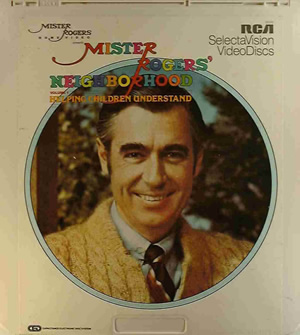
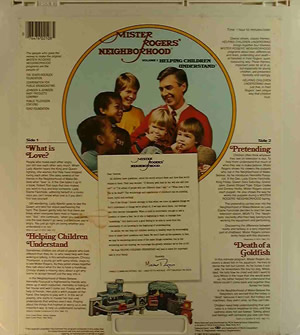
[Images courtesy of cedmagic.com]
Description
Side 1
- What is Love?
People who make each other angry can still love each other very much. When Lady Aberlin hears the King and Queen fighting, she worries that they have stopped loving each other. She asks several of her friends in the Neighborhood of Make-Believe what "love" is. X the Owl looks it up in a book. Robert Troll says that love makes you want to hug and kiss someone. Lady Elaine Fairchilde, admiring herself in a mirror, says you can't know what love is if you don't first love yourself.
Still wondering, Lady Aberlin goes to see the Queen and tells her about overhearing the fight. The Queen gently tells her that there are times when everyone feels mad or happy or sad. "But," she continues, "when you love someone the love doesn't go away just because you're angry. You just go right on loving whether you understand or not."
- Helping Children Understand
Sometimes children are afraid of people who look different than they do, or who need help with their walking or talking. In this sensitive program, Chrissy Thompson, a young girl with spina bifida, stops by to see Mister Rogers. As they polish shoes together, they talk about what it's like to have a handicap. Chrissy shares a moving story about a girl who learns to accept herself just the way she is.
In the Neighborhood of Make-Believe, Henrietta Pussycat is frightened by friends who dress up in witch costumes. Henrietta is hiding in her house and won't come out. Finally, with the help of friends, Hen puts a witch puppet on her hand. She begins to play with it. In the act of playing, she starts to master her fear and understands th at witches aren't real. Playing about the things that frighten or worry us is one important way to help us understand ourselves.
Side 2
- Pretending
Children often think whatever they see on television is real. To help them understand that much of what they see is make-believe, Mister Rogers shows his viewers the puppets who live in the Neighborhood of Make-Believe. As he introduces Henrietta Pussycat, X the Owl, Lady Elaine Fairchilde, King Friday, Queen Sara Saturday, Grandpere, Daniel Striped Tiger, Edgar Cooke, and Donkey Hodie, Mister Rogers voices each puppet. He also shows the way he works the puppets during a MISTER ROGERS' NEIGHBORHOOD taping.
The pretending carries over into the Neighborhood of Make-Believe as Lady Elaine Fairchilde decides to start her own television station, MGR-TV. The Neighbors excitedly offer their help taking turns working the equipment and performing.
Discovering that difference between reality and fantasy is a very important part of childhood. Mister Rogers consistently helps with this discovery.
- Death of a Goldfish
In this intimate program, Mister Rogers discovers a dead fish in his aquarium. He tries to revive the fish but cannot. As he buries it outside, he remembers the day his dog, Mitzie, died. He tells how he cried and didn't want to bury Mitzie in the hope that she would wake up. His father helped him understand that Mitzie couldn't come back and together they buried her body.
In the Neighborhood of Make-Believe, the Neighbors are worried that the trolley is "dead" because it won't run. But trolleys are machines. They aren't alive, so they can't die.
Children need help understanding that saddness is a natural response to loss and that sadness does not last forever. Talking about sad feelings with someone you love can help.
Images

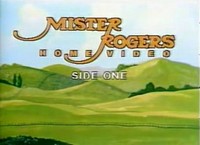
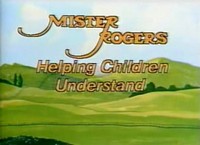
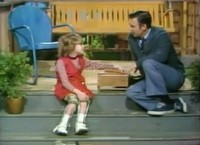
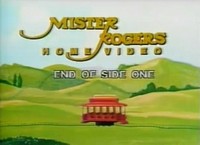
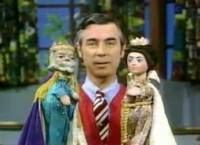
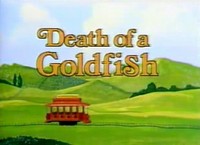
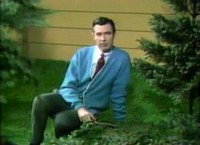
Notes
The four episodes included on this disc are Episode 1309 (What Is Love), Episode 1389 (Helping Children Understand), Episode 1384 (Pretending), and Episode 1101 (Death of a Goldfish). Some episodes are slightly abbreviated.
Credits
Credits vary with each episode on this disc. Please visit the individual episode pages for detailed credits.
